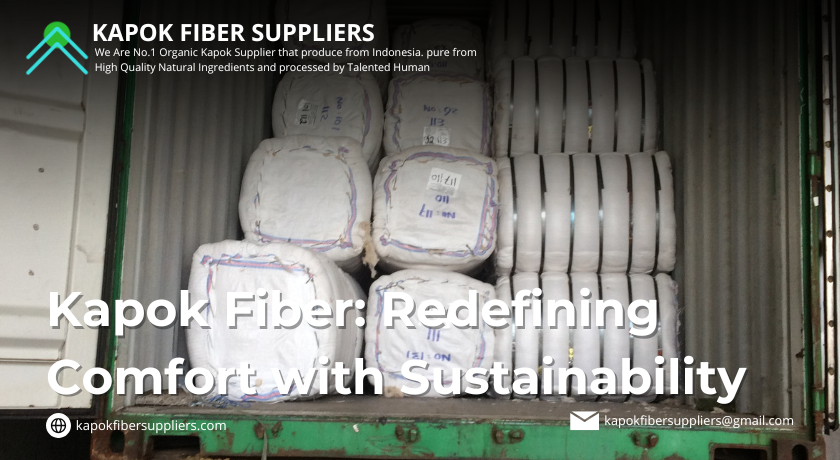
- What is Kapok Fiber?
- The Unique Advantages of Kapok Fiber
- Industries Transformed by Kapok
- Kapok Fiber and the Green Economy
- Why Kapok Fiber is the Future
- Conclusion
- What is kapok fiber?
- Why is kapok considered a sustainable material?
In today’s world, consumers no longer choose products based only on comfort or aesthetics. They are increasingly seeking eco-friendly, safe, and sustainable options that align with their values. This shift has put kapok fiber in the spotlight a natural material that not only offers luxury but also protects the planet.
What is Kapok Fiber?
Kapok fiber is derived from the seed pods of the Ceiba pentandra tree, a majestic tropical tree that thrives without chemicals or fertilizers. Inside its pods are silky, golden fibers that are naturally hollow and lightweight. For centuries, communities in Asia and South America have used kapok as filling material for bedding, life jackets, and cushions. Today, its applications are expanding across industries, proving that tradition and innovation can coexist.
The Unique Advantages of Kapok Fiber
- 100% Natural and Biodegradable
Unlike polyester and other synthetics, kapok naturally decomposes, leaving no harmful waste behind. - Light as Air
Its hollow structure makes it one of the lightest natural fibers, up to 80% lighter than cotton. - Naturally Hypoallergenic
Kapok’s natural resistance to dust mites and microbes makes it perfect for people with allergies or sensitive skin. - Excellent Thermal Regulation
It keeps the body warm in cool conditions and cool in warm weather, ensuring year-round comfort. - Water-Resistant by Nature
A thin natural wax layer coats each fiber, making kapok resilient in humid environments.
Industries Transformed by Kapok
- Bedding & Mattresses → Kapok pillows and mattresses provide breathable, supportive comfort.
- Sustainable Fashion → Jackets, coats, and outdoor gear now use kapok as a natural insulation alternative.
- Furniture Manufacturing → Sofas, cushions, and beanbags filled with kapok deliver comfort and durability.
- Eco-Packaging → Kapok serves as a biodegradable alternative to synthetic foams.
- Marine & Safety → Its buoyancy makes kapok an ideal choice for flotation devices.
Kapok Fiber and the Green Economy
With climate change and pollution concerns on the rise, industries are under pressure to adopt materials that reduce environmental footprints. Kapok fiber is a perfect fit for circular economy models because it is renewable, compostable, and requires minimal resources to cultivate.
Brands that switch to kapok can market their products as sustainable, ethical, and future-ready, appealing to eco-conscious consumers across the globe.
Why Kapok Fiber is the Future
The demand for natural, renewable resources is at an all-time high. Kapok stands out because it balances luxury comfort with environmental responsibility. It doesn’t ask manufacturers to compromise it gives them an advantage.
By integrating kapok, companies not only enhance product performance but also demonstrate leadership in the global movement toward sustainability.
Conclusion
Kapok fiber is more than just a natural filling it’s a symbol of sustainable innovation. Its versatility, eco-friendliness, and superior qualities make it the ideal choice for industries aiming to combine comfort with responsibility.
As consumers continue to demand ethical products, kapok fiber is set to become a cornerstone of eco-friendly manufacturing worldwide.
📌 Your Trusted Kapok Fiber Partner
For premium-quality kapok fiber with 15 years of export experience, connect with:
CV. Media Mitra Indonesia
📍 JL. Ir. Soekarno No. 122, Kota Batu, Jawa Timur, Indonesia
📧 kapokfibersuppliers@gmail.com | 📞 +62 859-3313-3244
🌐 kapokfibersuppliers.com | kapokfibre.com
FAQ
What is kapok fiber?
Kapok fiber is a natural, silky-soft material harvested from the seed pods of the Ceiba pentandra tree. Known for its lightweight and buoyant properties, it has been traditionally used in pillows, mattresses, and life vests.
Why is kapok considered a sustainable material?
Kapok grows wild without the need for irrigation, pesticides, or fertilizers, making it one of the most environmentally respectful fibers. The harvesting process involves collecting the fiber from naturally fallen seed pods, ensuring that the trees remain unharmed and the ecosystem is preserved.

